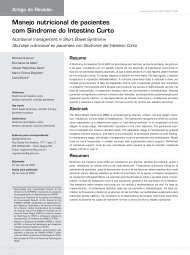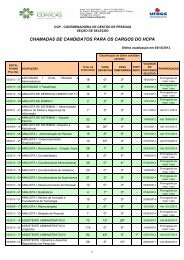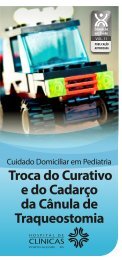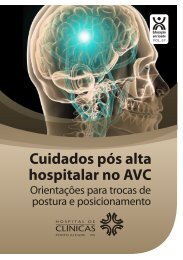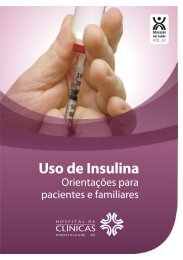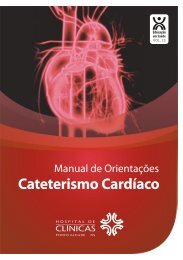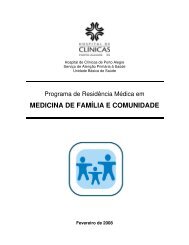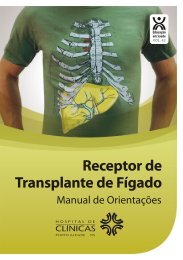Anais da 27º Semana CientÃfica - Hospital de ClÃnicas de Porto Alegre
Anais da 27º Semana CientÃfica - Hospital de ClÃnicas de Porto Alegre
Anais da 27º Semana CientÃfica - Hospital de ClÃnicas de Porto Alegre
You also want an ePaper? Increase the reach of your titles
YUMPU automatically turns print PDFs into web optimized ePapers that Google loves.
117<br />
Revista HCPA 2007; 27 (Supl.1)<br />
cerebral, aneurisma basilar, hemorragia subaracnói<strong>de</strong>a, tumores <strong>da</strong> fossa posterior e ativi<strong>da</strong><strong>de</strong> epileptogênica. O tratamento é<br />
realizado com anti-eméticos e analgésicos.<br />
Gastroenterologia<br />
INDUCTION OF IN VITRO DIFFERENTIATION OF RAT MESENCHYMAL STEM CELLS OVEREXPRESSING<br />
BETACELLULIN INTO BETAPANCREATIC CELLS.<br />
ANA HELENA DA ROSA PAZ; ANA AYALA, MARLON SCHNEIDER, EDUARDO PASSOS, ELIZABETH CIRNE-LIMA,<br />
LUISE MEURER.<br />
In Brazil, according to the last census (IBGE- 1989), it was estimated that 8 million people have diabetes. This amount of<br />
diabetic people represents a direct cost of approximately US$22 billions per year to the Public Health Program. A recent survey<br />
conduced in a Brazilian city, points out that at the present the prevalence of diabetes in Brazil must be much higher. In fact, the<br />
inci<strong>de</strong>nce and prevalence of diabetes is expected to increase around 30% by the year 2009. In type 1 or type 2 diabetes an<br />
insufficient mass of functional betapancreatic cells is the major <strong>de</strong>terminant for the onset of hyperglycemia. So the restoration of<br />
beta-cells number by transplantation from exogenous sources or by endocrine pancreas regeneration would be i<strong>de</strong>al therapeutic<br />
options. However a limited supply of human donor tissues or organs induce several researches towards the establishment of an<br />
alternative source of cells. In this vein, mesenchymal stem cells obtained from bone marrow, presents the ability to differentiate<br />
into a variety of cell types, including pancreatic cells. Besi<strong>de</strong>s, Betacellulin, a protein member of the epi<strong>de</strong>rmal growth factor –<br />
EGF, expressed predominantly in pancreas, has been applied to improve glucose metabolism in diabetic mouse(Li et al., 2003).<br />
To study the capacity of betacellulin to gui<strong>de</strong> the transdifferentiation of mesenchymal stem cells to beta-cells our group is<br />
working to produce overexpressing betacellulin mesenchymal stem cells. At the moment we are characterizing the mesenchymal<br />
stem cells using surface markers by flow citometry. Later the cells will be transfected with pCDNA3-BTC-EF plasmid and<br />
submitted to a differentiation protocol using 10Mm nicotinami<strong>de</strong>. After the differentiation the obtained cells will be analyzed<br />
using anti-insulin monoclonal antibodies and by RT-PCR.<br />
CONSUMO DE FUMO, ÁLCOOL, CAFÉ E CHIMARRÃO EM PACIENTES DISPÉPTICOS NÃO INVESTIGADOS<br />
FELIPE MAZZOLENI; RENATA HECK, GUILHERME B SANDER, CARLOS F FRANCESCONI, ALEXANDRO THEIL,<br />
NATAN KATZ, ANALIA MALDONADO, LUIZA B RENCK, CAMILA J LOPES, BRUNO S COLOMBO, FRANCIELE D<br />
DAHMER, MARIA LUIZA SANCHOTENE, RACHEL ZENKER, JOSIANE FISCHER, LUIZ EDMUNDO MAZZOLENI.<br />
HOSPITAL DE CLÍNICAS DE PORTO ALEGRE<br />
Introdução: Ain<strong>da</strong> não foram estabelecidos a importância <strong>de</strong> fatores alimentares e comportamentais na etiologia dos sintomas<br />
dispépticos. Objetivo: <strong>de</strong>screver a frequência <strong>de</strong> consumo <strong>de</strong> fumo, álcool, café e chimarrão em pacientes dispépticos não<br />
investigados. Material e Métodos: Pacientes com mais <strong>de</strong> 18 anos, com diagnóstico <strong>de</strong> dispepsia, segundo os critérios <strong>de</strong> Roma<br />
III, que aten<strong>de</strong>ram espontaneamente convite para participação no estudo publicado em mídia leiga. Os pacientes respon<strong>de</strong>ram a<br />
questionário dirigido por entrevistador, após assinatura <strong>de</strong> consentimento livre e esclarecido. Foram abor<strong>da</strong><strong>da</strong>s questões o<br />
consumo regular <strong>de</strong> álcool, <strong>de</strong> fumo, café e chimarrão. A coleta <strong>de</strong>stes <strong>da</strong>dos foi realiza<strong>da</strong> <strong>de</strong>ntro do projeto GGPG 05-422,<br />
aprovado no Comitê <strong>de</strong> Ética em Pesquisa do <strong>Hospital</strong> <strong>de</strong> Clínicas <strong>de</strong> <strong>Porto</strong> <strong>Alegre</strong>. Resultados: Foram avaliados 378 pacientes. A<br />
prevalência <strong>de</strong> tabagismo atual foi <strong>de</strong> 18,5% (70 pctes) e 26,5% (100 pctes) referiram passado <strong>de</strong> tabagismo. 55% (208 pctes)<br />
nunca fumaram. O consumo atual <strong>de</strong> álcool foi relatado por 16,7% (63 pctes), consumo no passado foi referido por 5% (19 pctes)<br />
e 78,3% negam o consumo <strong>de</strong> álcool. 64,6% dos pacientes consomem café e 41,5% consomem chimarrão regularmente.<br />
Conclusão: Observa-se uma eleva<strong>da</strong> prevalência <strong>de</strong> tabagismo atual ou passado nesta amostra <strong>de</strong> dispépticos (mais <strong>de</strong> 40% <strong>da</strong><br />
amostra). A maioria é abstêmia para bebi<strong>da</strong>s alcoólicas, mas há substancial proporção <strong>de</strong> pacientes que consomem café e/ou<br />
chimarrão.<br />
DISPEPSIA NÃO INVESTIGADA: TEMPO DE DOENÇA E ASSOCIAÇÃO COM GASTROENTERITES<br />
FELIPE MAZZOLENI; GELLINE M HAAS, ALEXANDRO THEIL, GUILHERME B SANDER, CARLOS F<br />
FRANCESCONI, OSCAR AUGUSTO BIRKHAN, LUIZA N LAGES, BIANCA HOCEVAR, BIANCA M SPINDLER, PEDRO<br />
P GUERRIERI, ROBERTA P LUNKES, CANDICE F KRUMEL, ENZO NARDELI, STELLA MARINI, LUIZ EDMUNDO<br />
MAZZOLENI. HOSPITAL DE CLÍNICAS DE PORTO ALEGRE.<br />
Introdução: O tempo <strong>de</strong> duração dos sintomas dispépticos po<strong>de</strong> ser um preditor <strong>de</strong> resposta terapêutica. Alguns autores sugerem<br />
que episódios agudos <strong>de</strong> gastroenterite (GEA) possam ser gatilhos para o início <strong>de</strong> sintomas dispépticos. Objetivo: avaliar o tempo<br />
<strong>de</strong> doença dos pacientes dispépticos <strong>da</strong> nossa população e estu<strong>da</strong>r uma possível relação com quadros <strong>de</strong> infecção intestinal agu<strong>da</strong>.<br />
Material e Métodos: Pacientes com mais <strong>de</strong> 18 anos, com diagnóstico <strong>de</strong> dispepsia, segundo os critérios <strong>de</strong> Roma III, que<br />
aten<strong>de</strong>ram espontaneamente convite para participação no estudo publicado em mídia leiga. Os pacientes respon<strong>de</strong>ram a<br />
questionário dirigido por entrevistador, após assinatura <strong>de</strong> consentimento livre e esclarecido. Foram abor<strong>da</strong><strong>da</strong>s questões sobre o<br />
tempo <strong>de</strong> doença e sobre a associação do início dos sintomas com episódios <strong>de</strong> GEA. A coleta <strong>de</strong>stes <strong>da</strong>dos foi realiza<strong>da</strong> <strong>de</strong>ntro do<br />
projeto GGPG 05-422, aprovado no Comitê <strong>de</strong> Ética em Pesquisa do <strong>Hospital</strong> <strong>de</strong> Clínicas <strong>de</strong> <strong>Porto</strong> <strong>Alegre</strong>. Resultados: Foram<br />
avaliados 378 pacientes. Foi observa<strong>da</strong> que apenas 7,9% (30 pctes) referiram início dos sintomas há menos <strong>de</strong> 1 ano. 39,4% (149<br />
pctes) referiram início dos sintomas entre 1 e 5 anos, e 52,6% (199 pctes) referiram ter sintomas dispépticos há mais <strong>de</strong> 5 anos. A<br />
associação <strong>de</strong> GEA e o início dos sintomas dispépticos foi referido por apenas 14 pacientes (3,7%), não havendo associação entre<br />
GEA e tempo <strong>de</strong> evolução dos sintomas. Conclusão: A maioria dos dispépticos do nosso meio apresentam doença <strong>de</strong> longa<br />
evolução, que po<strong>de</strong>, segundo a literatura, predizer resposta terapêutica menor. GEA não parecem ser um <strong>de</strong>senca<strong>de</strong>ante<br />
importante <strong>de</strong> sintomas dispépticos e não estão relacionados com o tempo <strong>de</strong> evolução dos sintomas.




